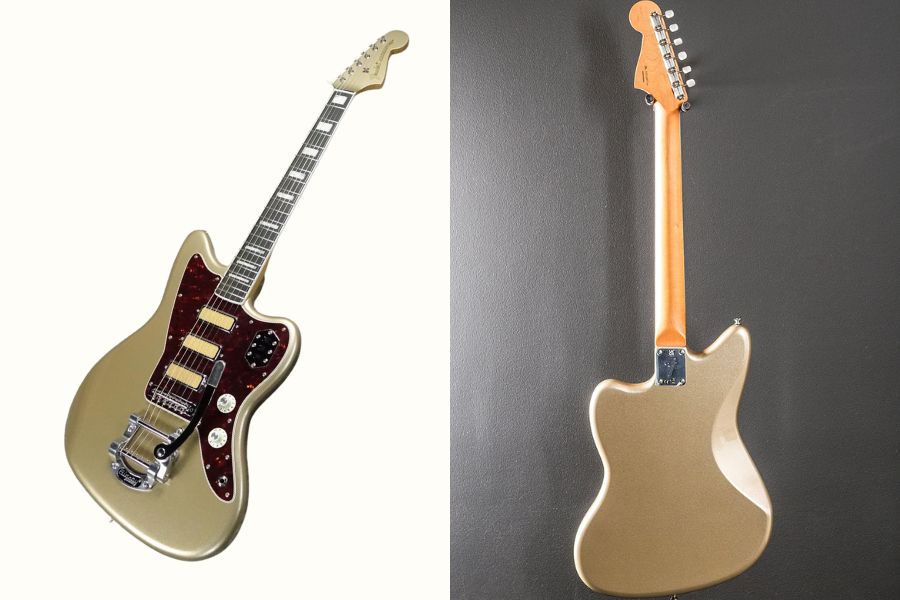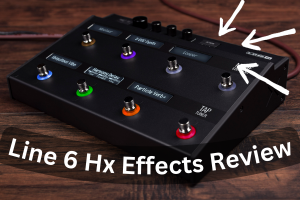Just like Fender’s other cool lines such as Vintera, Player Plus, Parallel Universe, and Limited Edition, the Fender Gold Foil Jazzmaster stands out. It’s got its own style and sound that makes it special. This model is likely from a special, limited run.
It has unique features like different pickup setups and cool designs. It’s perfect for collectors, musicians who need versatile sounds, and anyone who wants a guitar that looks awesome.
Let’s dive into what makes this guitar a one-of-a-kind and if it’s right for you.
Appearance and Aesthetic

In my opinion, the Gold Foil Jazzmaster is a well-executed blend of different design and hardware elements, making it visually attractive and sonically versatile, combining Gibson-like attributes (mahogany body and mini humbuckers) with Fender’s traditional Jazzmaster design elements. It features vintage 60C shaped maple neck with a bound ebony fretboard, three gold foil style pickups, a Jaguar-inspired pickup selector, a Bigsby B50 tailpiece and witch hat knobs. To a large extent, its distinctive look is due to the Bigsby tailpiece.
The guitar has a Shoreline Gold finish with a matching headstock, which enhanced its 60s aesthetic, and a faux tortoiseshell pickguard. The look is cool but the ebony fingerboard seemed unnaturally uniform, I suggest it to be dyed.
Candy Apple Burst is another finish that can be chosen. The finishes have pearloid block inlays that look like they were made after CBS, which makes the overall look even better.
The guitar look professional, but the included gig bag is kind of low quality to me. You might consider investing in a better case for gigging musicians.
Construction and Playability

Like general Fender guitar, the guitar features a solid mahogany body, maple neck with an ebony fingerboard, and lacks the traditional “jazz” controls found on other Jazzmasters.
Read more: Fender Gold Foil Telecaster Review
The build quality is excellent, the instrument feel luxurious, although some components like the tuning keys and control knobs are slightly lower quality compared to the rest of the guitar.
The “comfortable 60C shape with a 9.5-inch radius and equipped with 21 narrow high frets” neck design of the Fender Gold Foil Jazzmaster makes the guitar a lot easier to play and more comfortable to hold.
But there are some playability issues, too. At some points, this guitar is harder to use than the Jazzmaster or Jaguar vibrato systems.
First, the sharp edge on the fretboard binding is a notable difference, which I find to be a little uncomfortable.
It has a simpler control layout compared to traditional Jazzmasters, with three individual on-off sliders for each pickup, a single volume, and a tone control.
The problem is, I think these controls are set up more for “fire and forget” than for making it easy to make changes often. It’s because the volume control is placed forward and away from the bridge that volume swells can be hard to use, especially for people who don’t have long fingers. The guitar utilizes a traditional Fender offset bridge and a Bigsby B50 tailpiece and the arm on the Bigsby B50 tailpiece can also get in the way of using the controls.
Hardware and Sound Output

Instead of gold foil pickups, the guitar has mini humbuckers that are based on alnico. The mini-humbuckers are known for having less output and being more sensitive to pick attacks and changes in volume and tone settings. They sound distinctive when the amp is clean, but not as much when it is overdriven or distorted.
They are also known for midrange emphasis, which sounds great with some amplifier settings and black-panel Fender amps in particular. The combination of neck and bridge pickups offers a full-range sound with a sparkly top end and a warm low end.
When unplugged, the guitar was resonant and pleasing, but plugged in, I feel the sound across different pickup settings had mixed quality. There are specific suitable settings based on specific amplifiers.
The guitar has separate on/off switches for each pickup, which lets you get a wide range of sounds by mixing the pickups in different ways. For example, the neck and bridge pickups can be mixed to get jazzy sounds, or the middle pickup can be used to get a Bonnie Raitt-style slide guitar sound.
Conclusion
Overall,this guitar feels like an “old classic friend.” to me. I liked its pragmatic design and the variety of unique tones it offers.
I liked the guitar’s fit, finish, and its distinctive aesthetic appeal. However, it might not be the best choice for someone who already has a better Jazzmaster, and that quality can vary.









